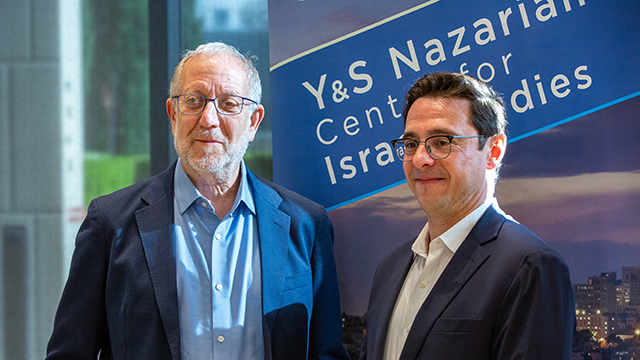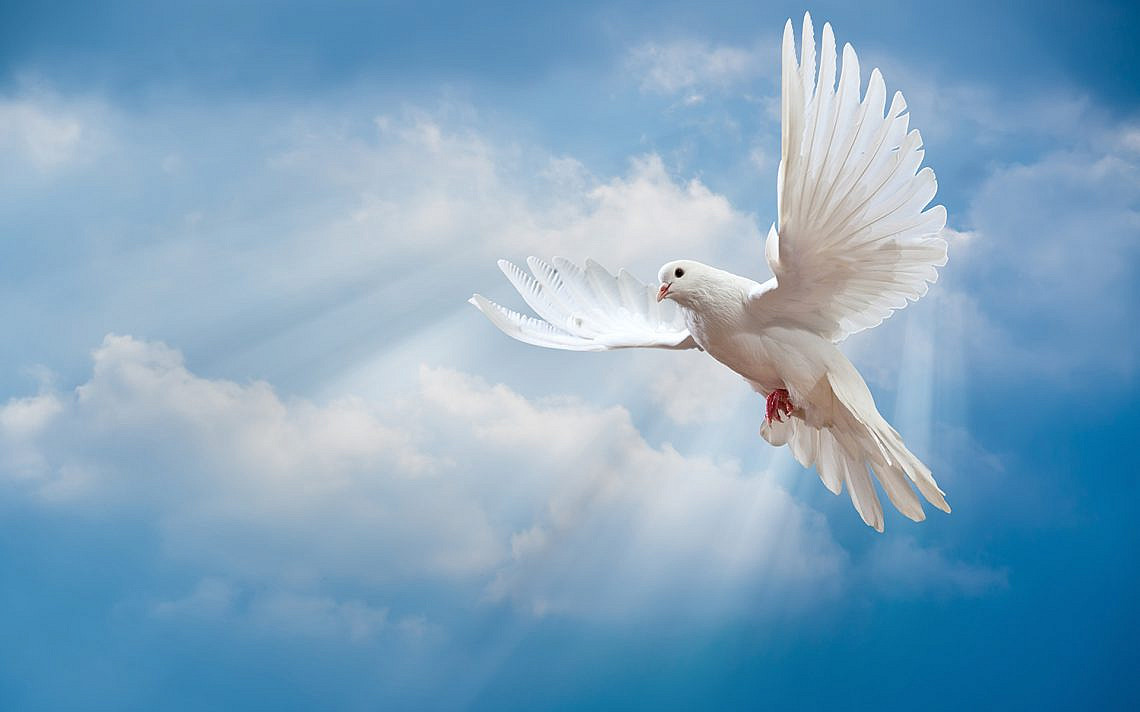

Fallen Soldiers and the Shekhina’s Wings 
Listen to the IDF’s chief cantor during the upcoming national ceremonies of Yom Hazikaron and Yom Ha’atzmaut and pay careful attention to the words of the “El Maleh Rachamim” prayer. Sometimes a single word, or even a single preposition, can make a world of difference.
Take note: Will the cantor ask for our dead to rest “under the Shekhina’s wings” or “above the Shekhina’s wings”?
Hebrew speakers are used to the term “under the Shekhina’s wings,” perhaps because of Hayim Nachman Bialik’s reference to the mother, the lover, or the Shekhina, with the words “place me under your wings,” in one of his most famous poems. Bialik alludes to a common phrase in ancient Hebrew. In one of the Talmud’s most famous stories, Rabbi Yohanan says to Resh Lakish, the former bandit: “I brought you under the Shekhina’s wings.”
What, then, motivates the IDF’s chief cantor to corrupt a phrase so full of motherly compassion, and to say “above the Shekhina’s wings”? Here is an explanation of a Hasidic master of the eighteenth century, Rabbi Zvi Elimelech Shapira of Dinov, in his book, Bnei Yisoschar:
The difference between the souls of Israel and the souls of converts is that the portion of the souls of Israel is above the wings of the Shekhina, for they are “carried from within the womb,” while the portion of the souls of converts resides underneath the wings of the Shekhina.
This explanation distinguishes between converts who are placed under the Shekhina’s wings, while Jews, “carried from within the womb” – that is, Jewish from birth (based on Isaiah 46:3), reside above the Shekhina’s wings, separate from converts. After death, space is divided hierarchically, expressed by one’s place surrounding the great Mother, the Shekhina. This is not simply an esoteric detail; it is a question of faith and values. Which Jewish traditions do we seek to give voice to?
The source of these words is from the Zohar, in the thirteenth century, which divides between Jews and converts in an absolute and hierarchical manner. The Zohar maintains that Jewish souls emanate from the Shekhina – the tenth emanation of the “tree of emanations”- while other souls emanate from lower levels of the emanations (sefirot). Therefore, converts cannot ascend the “Tree of Life” – the channel of Divine emanation – to a level higher than the level of Shekhina, which is described as gathering the converts under her wings:
Converts have no part in the upper tree, certainly not in its body. Their portion is in the wings [of the Shekhina] and no more… the convert [can reach] under the wings of the Shekhina, but no more.
This understanding is consistent with the Zohar’s conception that the soul of the convert comes from the “Other Side” (Sitra Achra), the area outside of holiness, which is impure, evil, demonic. After circumcision, the convert receives a new soul, but it remains inferior to the soul of a Jew from birth.
This tradition made its way into Jewish life through the Shla”h, Rabbi Isaiah HaLevi Horowitz, lived in Germany in the seventeenth century, and greatly influenced chassidut. It is related that the Shla”h “would castigate cantors who say ‘under the Shekhina’s wings,’ for by doing so they might bring the soul down, Heaven forbid, for ‘under the Shekhina’s wings’ is the place of converts…but the root of Israel is higher, and therefore they should say ‘above the Shekhina’s wings.’”
Even if we don’t fully understand the ways of elevation of Jewish and converts’ souls in the upper worlds, the words “but the root of Israel is higher, and therefore they should say ‘above the Shekhina’s wings’” are sufficiently clear: not only are Jews from birth more worthy, but the mere proximity to converts’ souls (note: not non-Jews, but sincere converts) negatively affects Jews in a fundamental way, and is likely to degrade them: “by doing so, they might bring the soul down.”
This is a clear deviation from the spirit of earlier Jewish sources. The phrase “above the Shekhina’s wings” is a foreign innovation. The Midrash talks about “Ruth the Moabitess, who entered underneath the wings of the Shekhina” (Midrash Mishlei, 31:5), and Maimonides also speaks of loving the convert who has “come and entered underneath the Shekhina’s wings” (Mishneh Torah, Laws of De’ot, 6:4). From these sources and many others, it is clear that the image is of the gathering of converts under the great Mother, the Shekhina, who protects the Jewish people who already take refuge under her wings, and who accept into their midst their brethren, the converts.
Thus, in the thirteenth century, Ovadiah the convert asks Maimonides if he may say the words “Our God, and the God of our forefathers” in prayer, because after all, our God is not the God of his fathers. On the other hand, he does not want to expose himself publicly as a convert. Without hesitation, Maimonides answers: “You should say ‘Our God and the God of our forefathers,’ because Abraham is your father,” and moreover, he adds: “and you should say ‘who endowed the land to our fathers,’ because the land was given to Abraham.” According to Maimonides, this land, for which converts fight today, belongs to them, just as it belongs to every other Jew.
The tradition of the Zohar represents the root of a branch of later Jewish thought, developed from the thirteenth century onward, which has to be recognized as containing racist (and often misogynist) assumptions, which influenced Jewish tradition and law, and which continues to influence it to this day. Academic historical research suggests that the philosophy of the Zohar reflects opposition to Christian theology and to conversion practices of the Catholic church, but this is irrelevant. The content of the Zohar is still interpreted here and now, and it carries messages that are morally problematic in the Jewish and Israeli context of 2019.
It needs to be understood that these racist assumptions separate not only among the dead, but also among the living. The IDF invests a great deal in “Nativ” courses, so those who are Israeli citizens under the Law of Return will undergo halakhic conversions, but according to this Jewish tradition, if God forbid, one of these righteous converts is killed defending the land, they are separated from their brothers in arms: they are under the wings of the Shekhina, while their brothers are above them.
We should recognize that theology never ends with the “upper realms.” It trickles down into the halakha, into traditions, and into daily reality, in ways that reflect its values. Indeed, this is how it ought to be, and therefore, we need to fight for our theological conceptions. In the context of thinking of the heavenly and earthly realms, I would note that changing the wording to “above the Shekhina’s wings” also changes the mythic picture from a gathering under the wings of a merciful mother, to a place of superiority and power, above the wings. That is, a picture of less humility and neediness. Is this what we need?
The version that reads “above the Shekhina’s wings” is not the only alternative available. With a simple search on YouTube, one can hear Yossele Rosenblatt, one of the greatest cantors of all time, chanting the “El Maleh Rachamim” prayer, and saying “under the Shekhina’s wings” (at 0:35). In contrast, the same search will yield the IDF’s chief cantor, Shai Abramson, at the official ceremonies at Yad Vashem (at 0:45), at the Rabin memorial ceremony (0:45), and on Memorial Day (0:45), consistently singing “above the Shekhina’s wings.”
I suspect that this was not the cantor’s choice, but rather that of someone in the military’s chief rabbinate responsible for designing official religious ceremonies, who intentionally chose this version, and thus did damage to the fundamental values that allow the Army to fulfill its function of creating unity and national loyalty.
This choice also highlights the responsibility of all of us – the religious, secular and traditional public – to insist on learning, knowing, and understanding. We should not meekly submit, often out of ignorance, to every decision made by this body. Do we want these to be the values expressed by the cantor of the Israeli army? (And why, in fact, is there no place for the Sephardic version of the prayer?)
I suggest that we return to the position expressed by our sages and Maimonides, which echoes the command “and you shall love the convert,”and adopt the image of the mother protecting her young under her wing, while rejecting the position that undermines our very existence. A difference of one word can reflect an entire worldview. Let us listen carefully to the prayers of the army’s chief cantor and pray that all of our fallen will together be shielded under the Shekhina’s wings, and that their merit will protect us all, so that we may also live together while on this earth.
Translated from Hebrew.
You care about Israel, peoplehood, and vibrant, ethical Jewish communities. We do too.
Join our email list for more Hartman ideas